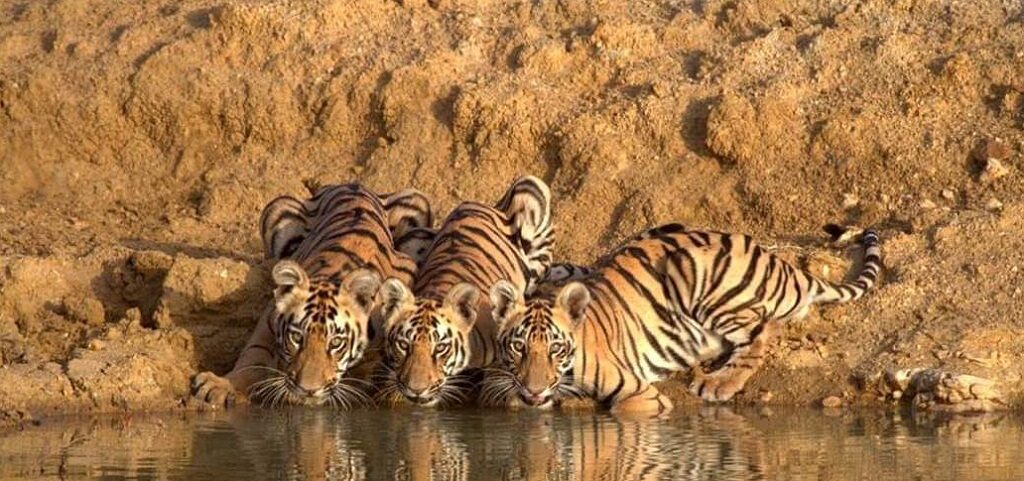Managing Human-Wildlife Interface in Chandrapur

Mumbai, July 27, 2019: On the occasion of “International Tiger Day”, Maharashtra Village Social Transformation Foundation (MVSTF) withWildlife Conservation Trust (WCT) today released a report on the current scenario of human-tiger conflict and work done by them in last two years.
The Maharashtra Village Social Transformation Foundation (MVSTF) was set up by the Government of Maharashtra, with support from leading corporates, with an aim to create a public-private partnership that aids holistic development in rural Maharashtra.
The objective is to integrate multiple developmental goals — including skill training, education, water security and environment protection in over 1,000 villages in a way that is scalable, sustainable and self-enforcing.
Wildlife Conservation Trust (WCT) has partnered with VSTF to provide technical inputs to 49 villages in the BramhapuriDivision of the Chandrapur District of Maharashtra that are critical from the perspective of forest and wildlife conservation.
WCT and the MVSTF signed a MoU for a collaborative effort to contribute to holistic development of a cluster of 49 villages in two Talukas of Nagbhid and Chimur in the Chandrapur district, with special emphasis on human-wildlife interface management as these villages are surrounded with forests and wildlife. The cluster approach will enable maximize the impact on the landscape.
Forty-nine villages from 21 Gram Panchayats from are covered under this programme (ANNEX I). Currently, nine Gram Panchayats with 20 villages have been allocated the CMRDF’s (ANNEX II). The region comprising of these villages is a large complex landscape of multi-use areas, large ranging carnivores, forest dependent communities, human-wildlife conflict, anthropogenic pressures on forests and varying hydro-sheds.
Looking at the nature of this project WCT took an interdisciplinary approach towards this cluster. Four verticals, Conservation Research, Conservation Behavior, Livelihoods and Education work simultaneously in this region approaching towards an all-round development of the communities.
Each village has been allotted a CMRDF. The role of a CMRDF is to understand the structure and functioning of each of the villages that fall under her/his Grampanchayat and help towards generating a Village Development Plan along with theGramsevak and Grampanchayat and implement the activities planned under the VDP. They also help in fund allocation and bring in understanding of the various schemes.
Communities in these villages face conflict with both, herbivores and carnivores. WCT helps in hand holding of the CMRDF’s to handle these conflict issues. Various workshops have been conducted for the CMRDF’s to understand the nature of the area that they are working in. These areas have apparent human-animal negative interactions and as an organization WCT helps towards generating awareness about these issues among the CMRDF’s and the communities. There have been several technological interventions deployed in the region to help manage this conflict.
To address the carnivore conflict real-time monitoring cameras have been installed near the areas in the villages adjoining forests to monitor the carnivore activity and if any large animal like the tiger, leopard or bear is moving towards the village information regarding its movement is passed onto the respective forest guards and the range forest officers.
Crop depredation by wild boars, Sambar, spotted deer, Nilgai, Gaur etc. is a major problem expressed repeatedly by farmers in the villages. The landscape has seven types of herbivore presence, wild boar, gaurs, Nilgai, Sambar, Chital, four horned antelope and Muntjac who raid crops during the night. Wild boars are perceived to me most notorious and highly destructive towards crops and are also known to be aggressive towards humans. On the top of it all, tigers tend to follow these animals which cause conflict.
To tackle the herbivore conflict WCT used technology-based measures called Foxlights in this landscape to understand their effectively to hinder herbivore movement towards the farms adjoining forest areas.
FOX LIGHTS:
Fox lights were discovered by Ian Whalan in Australia to keep foxes away from attacking his sheep. Fox lights are predator deterrent lights for night predators. They have been used for various purposes across the world like keeping the Himalayan black bears away from coming towards villages in the Himalayas or to keep the kangaroos and ducks from damaging the crop in Australia.
They create perception of someone flashing a flashlight. These Foxlights range from a single color lights to 3 colored lights (white, red and blue). Each fox light has 9 bulbs which blink in a random fashion to generate random pattern from the lights. The random patterns cause confusion in the predator resulting into avoiding coming towards the farm. The light is projected at 360 degrees and is visible for a distance of 2 kms (if there are no obstructions).
Field test was conducted in the MVSTF villages of Kacchepar, Nanded, Kawdashi & Lawari on four different crop types; fox lights were set up in a farm adjoining the forest with the land owner’s consent. Camera traps were set up in order to monitor the activity of animals. The details of these are as below:
| Sr no. | Village name | Type of crop | No of lights | Distance from forest (km) | Duration of deployment (days) |
| 1 | Kavdashi Deshmane | Chana | 12 | 2.6 | 30 |
| 2 | Lawari | Wheat | 30 | 0.02 | 15 |
| 3 | Nanded | Sandalwood | 10 | 1.22 | 30 |
| 4 | Kacchepar | Rice | 15 | 0.02 | 15 |
In each of the deployment incidents the farmers have reported reduction in the instances of raiding by wild boars in their farms. However, a conjunction of alternatives that target other senses like smell and sound along with the lights will also be tried on to further minimize the attacks.








